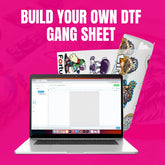How to Make DTF Transfers Without a DTF Printer
Wondering how to make DTF transfers without a DTF printer? You are not on your alone. Though many novices and do-it-yourselfers like to try DTF printing, they cannot afford a dedicated printer yet. Fortunately, a standard inkjet printer with little adjustments and the correct materials can transfer DTF heat. This article will walk you through every phase to help you understand the procedure. Every aspect counts from design to printing, curing to pressing. Here, the objective is basic: show you how to create DTF transfers using tools you could already own at home.
What Design Software Should You Use To Start The Process?
Creating or selecting your design with programs like Photoshop, CorelDRAW, or Canva will help you start learning how to do DTF transfers. Your file should be high resolution; an aim of 300 DPI will help to guarantee crisp detail when printed. Remember also to reflect your image, particularly if it includes text. In this sense, the DTF transfer looks right when it is applied to the cloth. Using the sRGB color profile is also wise since DTF printing might change tones throughout the transfer, so maintaining consistency in your colors.
Can An Inkjet Printer Really Replace A DTF Printer?
Although a real DTF printer is best, an inkjet printer can be adjusted to manage simple DTF printing. You will need premium pigment ink; normal ink will not stick properly to DTF paper. Load your DTF paper so the matte side faces upward. Most mistakes occur here; hence, check twice. Let your design sit for a few minutes once it comes out printed. This helps stop powder smudging when you add it. Take your time; stats show that hurrying this drying stage causes over 40% of botched diy DTF transfers.
How Do You Apply And Cure The Adhesive Powder?
Over your design, sprinkle hot melt adhesive powder once the ink is still only a little tacky. Cover it holistically. During heat pressing, this powder helps your image to merge with fabric. Shake off the extra very gently. Solve the powder now. One can accomplish this by hovering a heat press or a heat gun. Just enough melting of the powder should make it glossy; but, avoid overdoing it. The final DTF heat transfers either are made or broken by the curing stage. Actually, studies reveal that under-cured powder increases the 60% likelihood of breaking following washing.
What Steps Are Involved In Transferring The Design Onto Fabric?
Pressing your cured DTF transfer comes next. Laying your clothing flat, preheat your heat press to about 320°F. Print side down; first smooth out creases before putting the film. Press for fifteen to twenty seconds at medium pressure. After done, let it cool gently. Peels the DTF film gently. Your design should be fastened to the cloth now. Press once more for a few seconds if it seems loose or unfinished. Understanding DTF transfers also helps one to master the final press, thereby sealing the ink into the cloth fibers.
How Do You Get Better Results Without A DTF Printer?
You can better your results even without a suitable DTF printer. Use powders and DTF-specific film. Work on your curing method; undercuring or overheating causes issues. Test several textiles as well: cotton, polyester, and mixes all accept DTF printing differently. Pressing should not be followed by 24-hour washing of the garment. This allows the powder and ink time to adhere completely. Store extra printed DTF transfers flat, in a dry environment finally. That keeps them new for the next usage. Your ability to create DTF heat transfers will get better over time only employing experience.
Conclusion
Making DTF transfers without a DTF printer requires patience and some inventiveness. To start, you will need a robust inkjet printer, DTF paper, excellent powder, and a heat press. Although this arrangement isn't ideal, it's an excellent approach to understanding the fundamentals of DTF printing prior to more significant expenditure. Following these thorough guidelines will help you create graphics that appear professional and hold through several washings.
Ready to explore tools and supplies for your next print? Visit DTF Transfer Art to find high-quality products for every stage of the DTF process.
- bulk dtf transfers
- bulk printing
- Cotton for DTF
- custom apparel printing
- custom gangsheet
- Custom gangsheet DTF transfer sheets
- Custom gangsheet printing
- Custom Gangsheets
- custom heat transfers
- Custom iron patches
- custom prints
- decal transfers
- Digital printing
- Direct-to-Film Transfer
- dtf business
- DTF gangsheet
- DTF Heat Press
- dtf print shop
- DTF printer supplier
- DTF Printing
- dtf transfer
- dtf transfer art
- dtf transfer film
- dtf transfer instructions
- dtf transfer paper
- DTF transfer paper suppliers
- dtf transfer printer
- dtf transfer sheets
- DTF transfer supplier
- DTF transfer wholesale
- dtf transfers
- dtf transfers near me
- dtf transfers ready to press
- dtf transfers wholesale
- dtf wholesale
- gangsheet printing
- heat press printing
- Heat press settings
- Heat settings for DTF
- heat transfer decals
- heat transfer method
- heat transfer printing
- Heat transfers
- hot peel DTF
- iron-on decals
- Leather DTF transfers
- premium DTF transfers
- Print shops near me
- reliable DTF transfer printer supplier
- Stretch fabrics DTF






